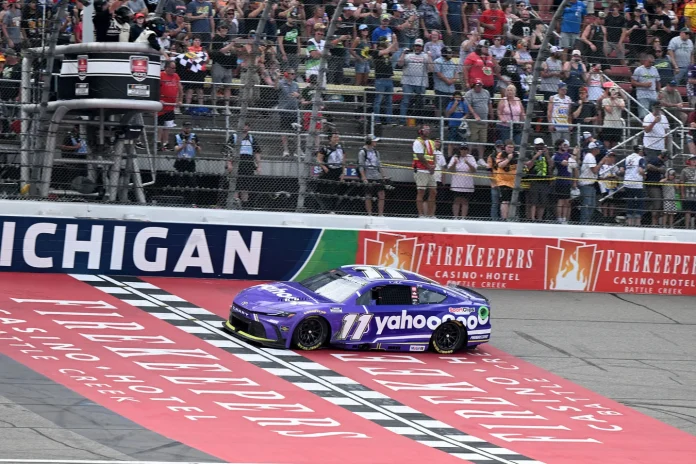Denny Hamlin reveals Dale Earnhardt Jr. inspired retirement plans as he considers his future in NASCAR, reflecting on a distinguished career and looking toward a transition similar to that of Hall of Famer Dale Earnhardt Jr. The veteran racer, fresh off his milestone 701st start and recent Michigan win, is contemplating a life after full-time racing that blends ongoing competition with new professional pursuits.
Hamlin’s Career Milestones and Influence of Earnhardt Jr.
Denny Hamlin’s accomplishments in NASCAR are widely recognized, with over 700 career starts and an impressive 57 race wins, highlighted by his latest triumph at Michigan. Despite facing doubts from critics who questioned his longevity and even embracing a sometimes controversial reputation within the sport, Hamlin has consistently proven his skill on the track.
Throughout his journey, Hamlin has drawn inspiration from fellow racer Dale Earnhardt Jr. Earnhardt Jr.’s transition away from full-time competition has set a new standard for retirement in the sport, with continued involvement through media, on-track appearances, and selective races. Hamlin now openly discusses his desire to emulate this approach as he approaches the later stages of his own storied career.
Dale Earnhardt Jr. has predicted that Hamlin’s winning days may be limited, yet Hamlin remains energized and motivated. As a soon-to-be father of three, he has begun outlining a potential future that echoes the multifaceted path taken by his respected peer, highlighting a willingness to remain connected to NASCAR in dynamic ways even after stepping away from the intense rhythms of full-time competition.

Planning for Retirement: A Gradual Transition Out of NASCAR
Hamlin acknowledges the challenge of walking away from the sport that has defined his adult life. He credits Dale Earnhardt Jr. with providing a model for post-retirement activity, suggesting that a sharp break from racing would be difficult. On Dale Earnhardt Jr.’s podcast, Hamlin shared his appreciation for Earnhardt Jr.’s ongoing involvement with select races and appearances in the Xfinity Series.
“I think it would be tough for me to just cut off, like, totally stop. I like what he’s (Dale Earnhardt Jr.) doing, dabbling, going to racetracks that you like, in the Xfinity Series or something like that.
—Denny Hamlin, on Dale Jr.’s podcast
This sentiment underscores Hamlin’s intention to remain active in motorsports on his own terms, perhaps competing in limited events that allow him to pursue his passion without the full commitment of a Cup Series season. He suggests that continuing as a part-time participant, especially in selective venues, offers a satisfying balance between racing and life off the track.
Setting Realistic Expectations for Life After Full-Time Racing
With nearly two decades of experience in the NASCAR Cup Series since his debut in 2006, Hamlin recognizes the eventual need to make difficult decisions about his future. He candidly discusses the competitive challenges of part-time racing, expressing awareness that maintaining top-level performance becomes harder without the consistent demands of a full schedule.
“It’s hard to do well in Cup part-time. So, I’m very realistic with my goals and I certainly don’t want to show up when I know I can’t win.
—Denny Hamlin
Hamlin’s perspective is both pragmatic and passionate. Drawing upon the paths of veteran drivers like Dale Earnhardt Jr., he is motivated to avoid the pitfalls of declining performance and disappointing outings late in his career. Instead, he wants any participation after retirement to be meaningful, intentional, and, above all, competitive.
While Hamlin does not anticipate immediate retirement, the discussion signals a thoughtful approach to winding down his time in NASCAR. He emphasizes the importance of self-awareness and personal standards, seeking to exit the sport on a high note and build a legacy that extends beyond just on-track results.
The Impact of Hamlin’s Future Decisions on NASCAR
Although Denny Hamlin’s full-time retirement may still be a few years away, his openness about echoing Dale Earnhardt Jr.’s journey is likely to influence how other athletes view career transitions. By considering selective engagement in racing and other professional activities, Hamlin is setting a new standard for how elite drivers can shape their post-competition identities.
As age becomes just a number for Hamlin, his relentless drive and impressive performance will continue to inspire both fellow racers and racing fans. His approach emphasizes pursuing realistic goals, staying involved with passion, and knowing when to step aside from the regular demands of the NASCAR Cup Series. The evolution of his career, and eventual retirement, is poised to leave a lasting mark not just on the track, but on the very culture of the sport itself.

